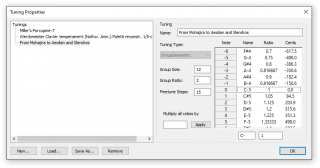Manual: Tuning Properties
Jump to navigation
Jump to search

The Tuning Properties dialog is used to create and edit advanced sample tunings.
Collection List[edit]
This is the big list on the left side of the window. It keeps all the tunings that you have imported into OpenMPT. There are two categories in this list:
- If you create a new tuning or import a single tuning, it will be added to the Tunings category. Tunings in this list can be used in your module.
- Loading legacy tuning collection files (.tc files) adds a new category for each tuning collection. Such imported tunings cannot be used in the module until you copy them to the Tunings directory by dragging them there with the mouse.
Tunings can be moved and copied between categories by dragging them to the wanted category. When releasing the mouse button, a popup menu is displayed from which you can choose the desired action — moving or copying the tuning.
Below the tuning list, the following buttons are found:
- New: Adds a new tuning to the Tunings category.
- Load...: Imports an OpenMPT tuning (.tun), OpenMPT tuning collection (.tc) or Scala scale file (.scl).
- Save As...: Saves the selected tuning as an OpenMPT tuning (.tun) or Scala scale file (.scl). If a collection header is selected instead of an individual tuning, all tunings under that header can be mass-exported.
- Remove: Unloads the selected tuning.
Tuning Types[edit]
Right-clicking the Tunings category or clicking the New buttons allows you to add a new tuning. The following tuning types exist:
- Group Geometric allows pitches to be independent within a group (octave). The pitch of notes outside the group size is determined by the Group Ratio factor.
- Geometric calculates by number of pitches in an “octave” (called a group size), and the pitch change in the “octave”. Using this method applies the equal temperament algorithm (based on an integer root of 2), but there is a lot less flexibility in naming notes.
- General is a tuning type with no enforced symmetry where all note pitches have to be entered manually. While the obvious disadvantage of this type is that you have to set the pitch for every note manually, this setting is especially useful for unpitched, strangely-pitched, or unusually-named notes, such as experimental tones or drum sets.
Tuning[edit]
- Name: Here, you can give your tuning a name that is shown in the tuning collection.
- Tuning Type: Shows the selected Tuning Type of the current tuning. Once a tuning type has been chosen, it cannot be edited.
- Group Size: The number of notes in this tuning's “octave” (which does not have to be an octave in the classic sense at all). You can enter a number in this field to define how many notes are in a note group (the Western European chromatic octave has 12 notes, the diatonic has 7, and the whole note scale has 6).
- Group Ratio: The frequency multiplier between the base note and the note one “octave” higher. This value does not need to be an integer number. The default octave is 2.
- Finetune Steps: The number of divisions that are between notes that will be used in portamento. In other words, the higher this setting, the higher the portamento value must be to bend the pitch by one note. The number of portamento finesteps needed to advance a step in the tuning is this value + 1, so the default of 15 + 1 = 16 finesteps needed. If this value is 0, finesteps equals note steps, which is the same as a glissando effect, using the pitches in the note list.
- Multiply all ratios by: This allows the ratios of all notes to be multiplied by a constant factor. This is not available for Geometric tunings, where the first note of the middle octave always has a ratio of 1 and the other ratios are derived through the group size.
- Note List: Shows all notes that can be played (C-0 to B-9) and the corresponding pitch ratio and cents. Clicking on any note centers the selection in the window, and shows the note attributes below the window, where the note name and ratio can be edited. For Geometric tunings, the ratios cannot be edited because they are derived through the group size.